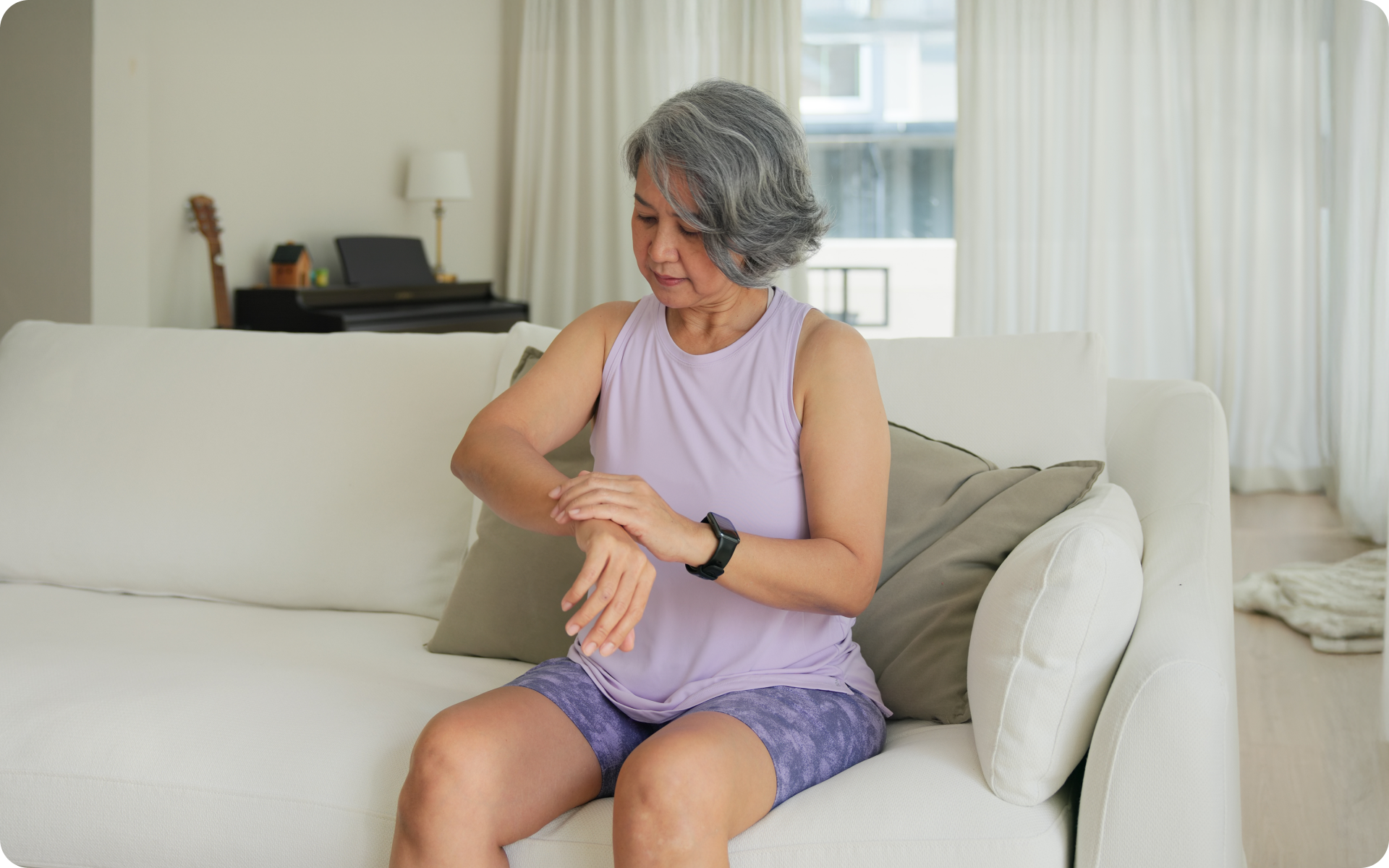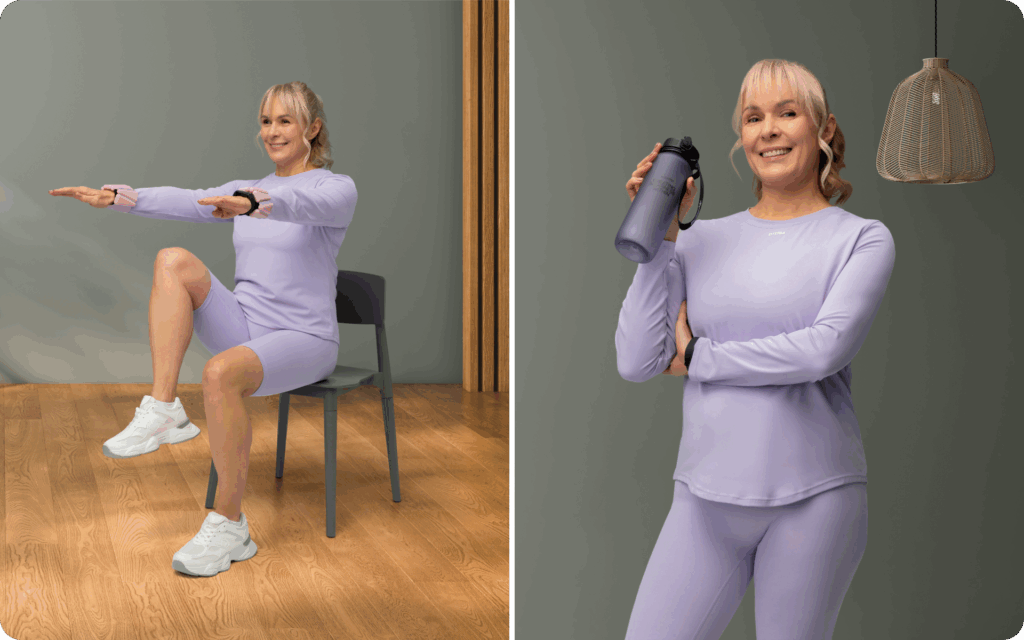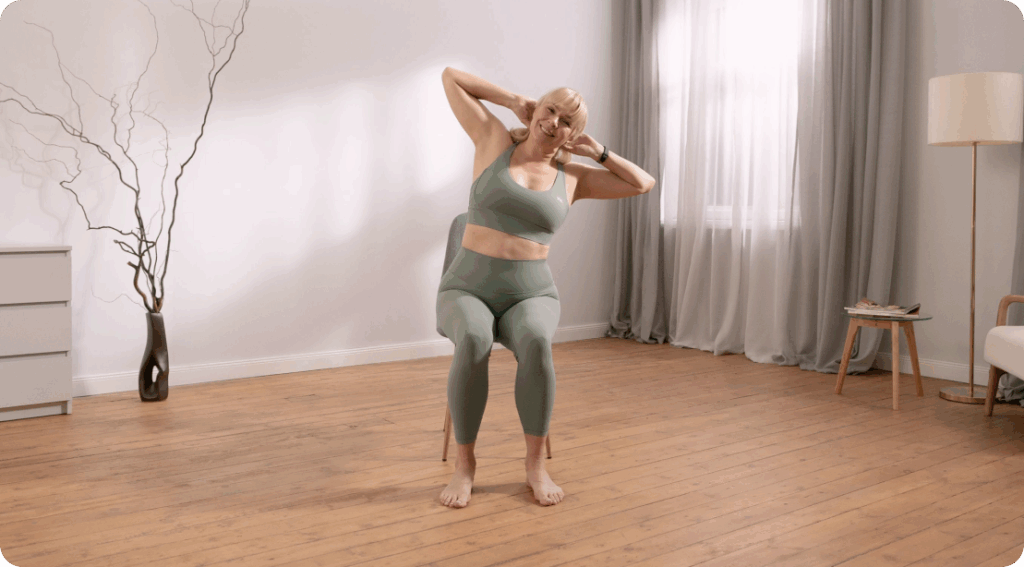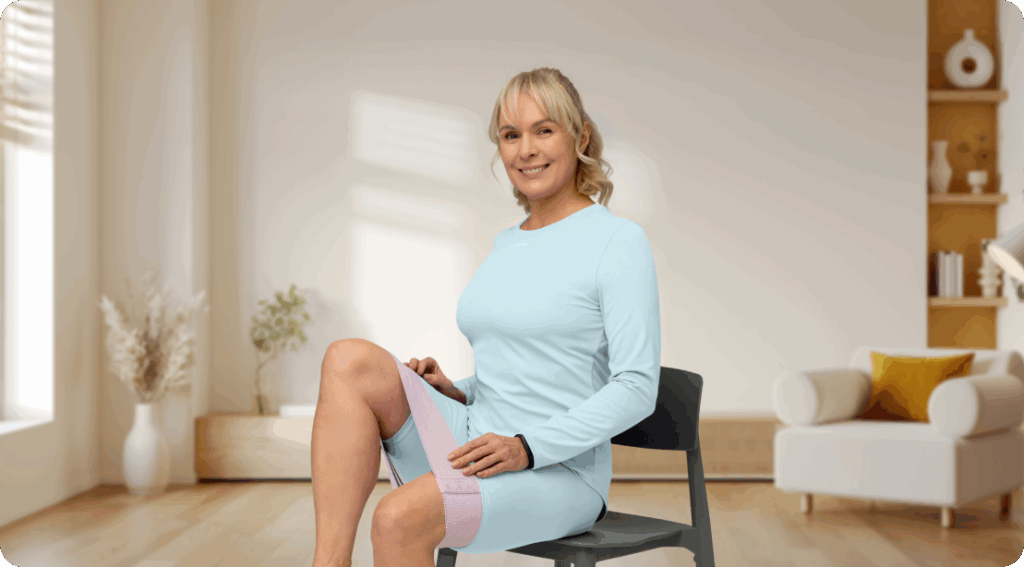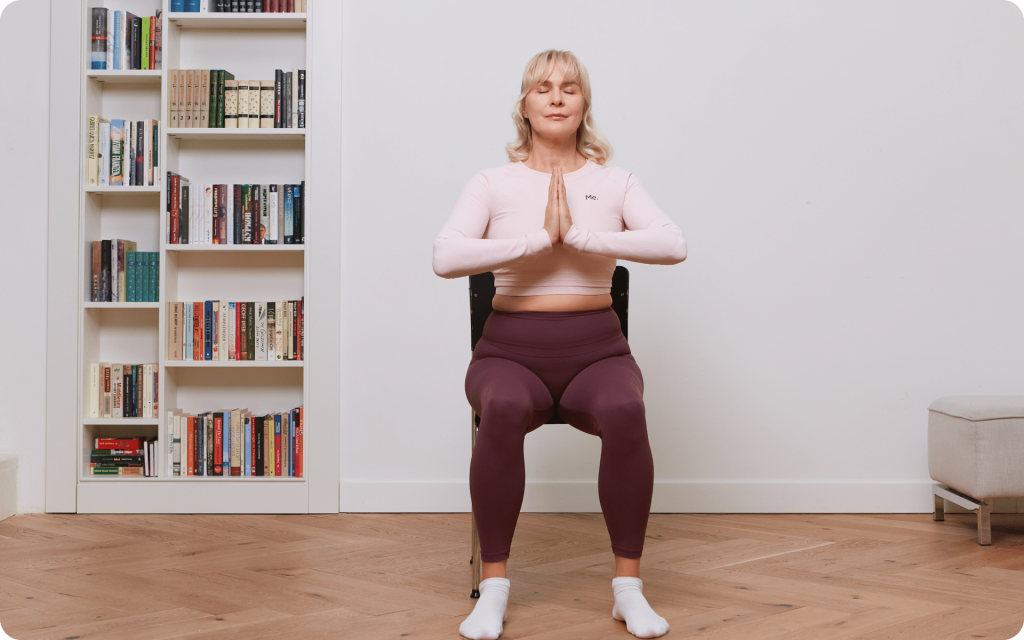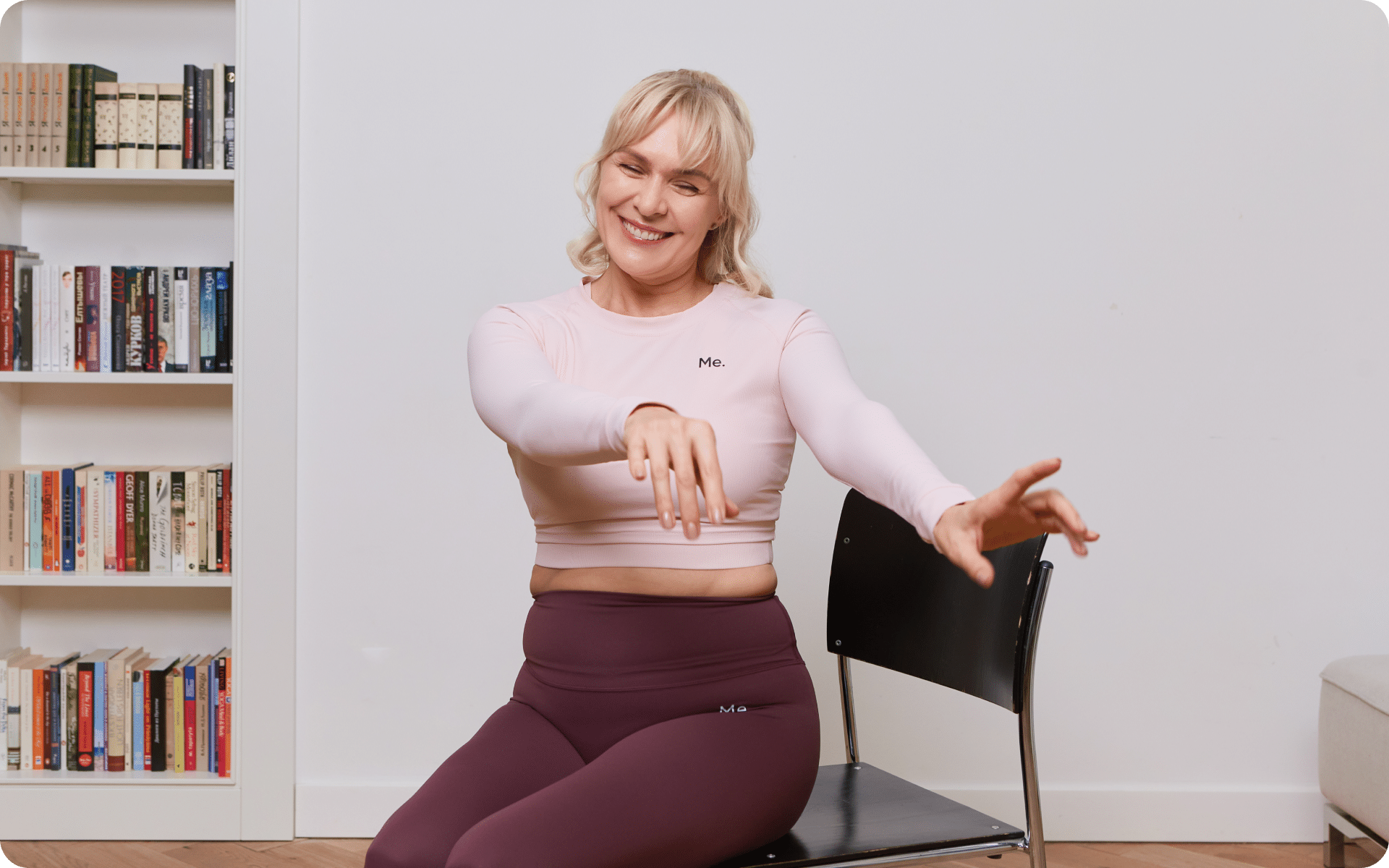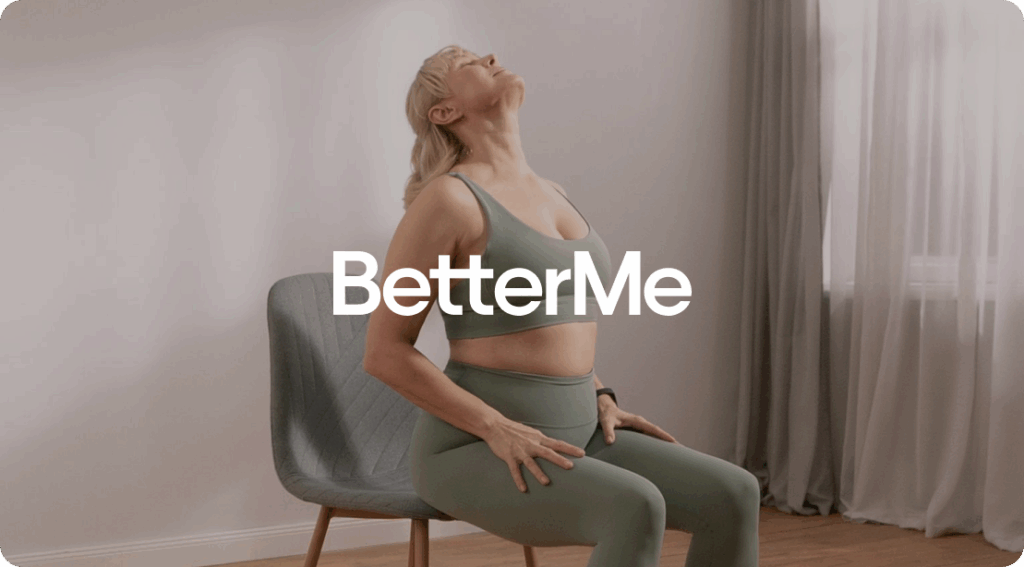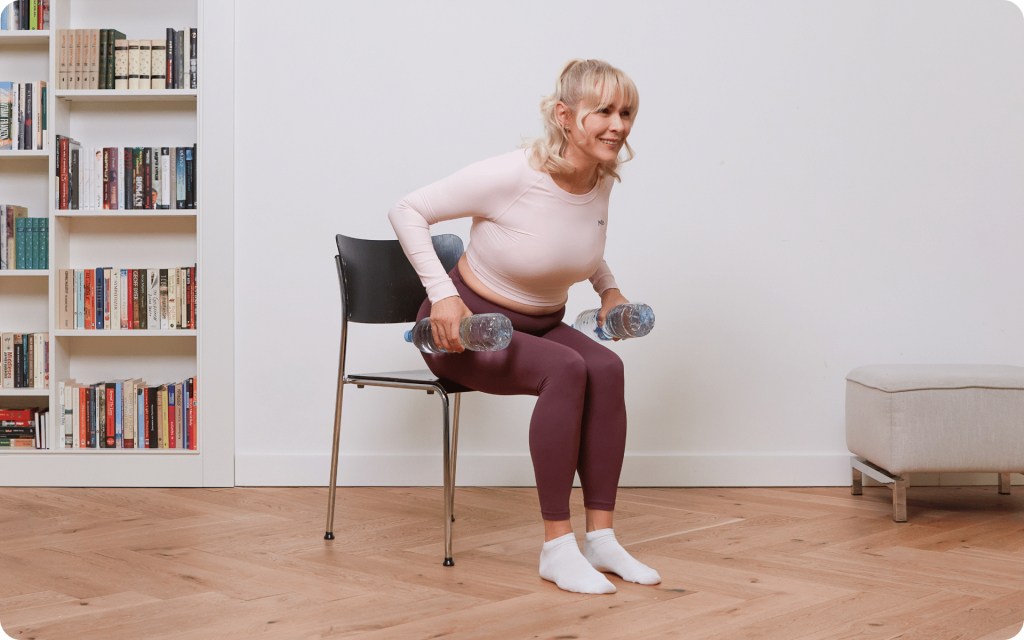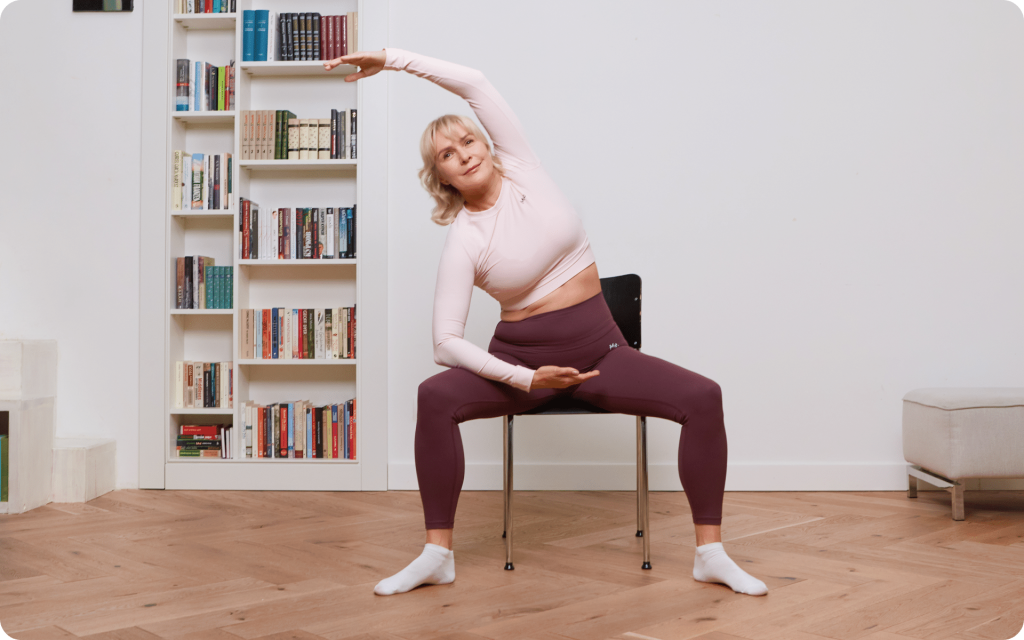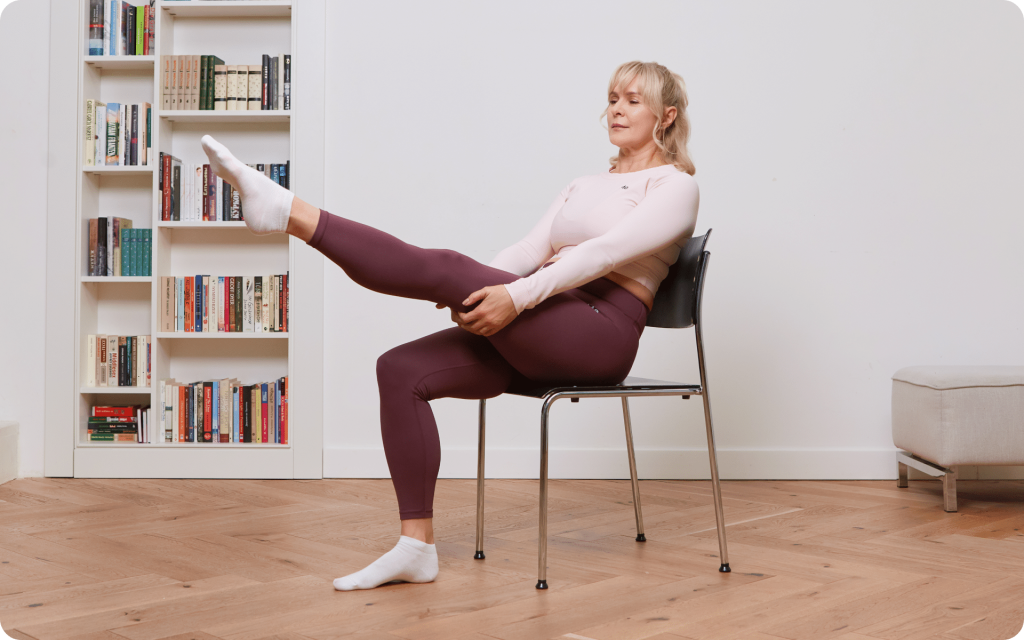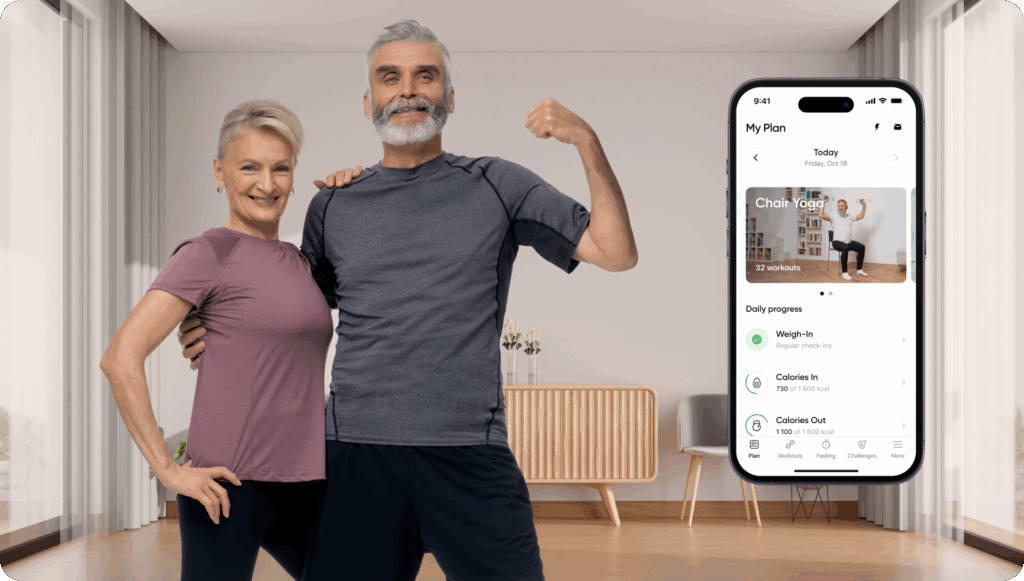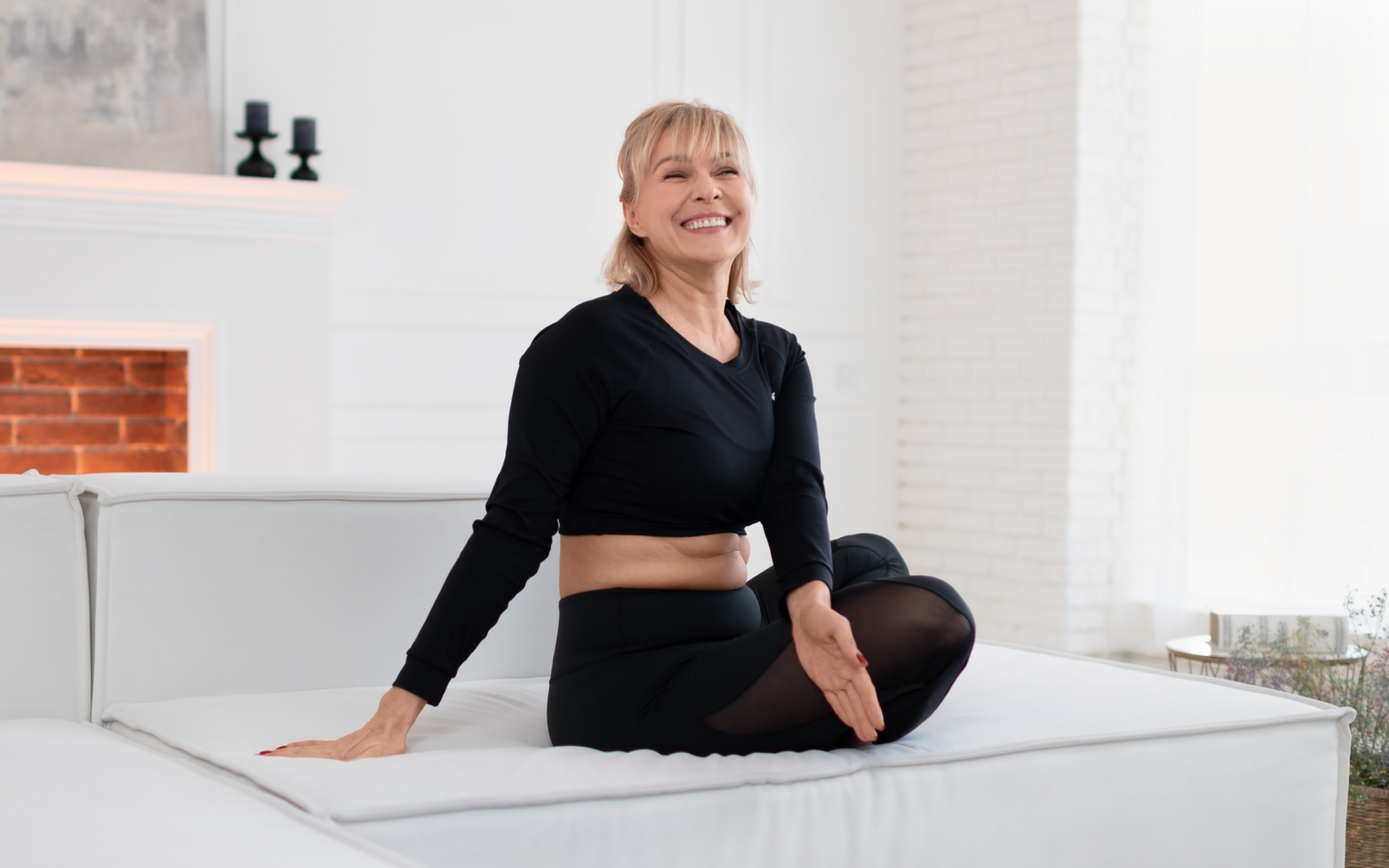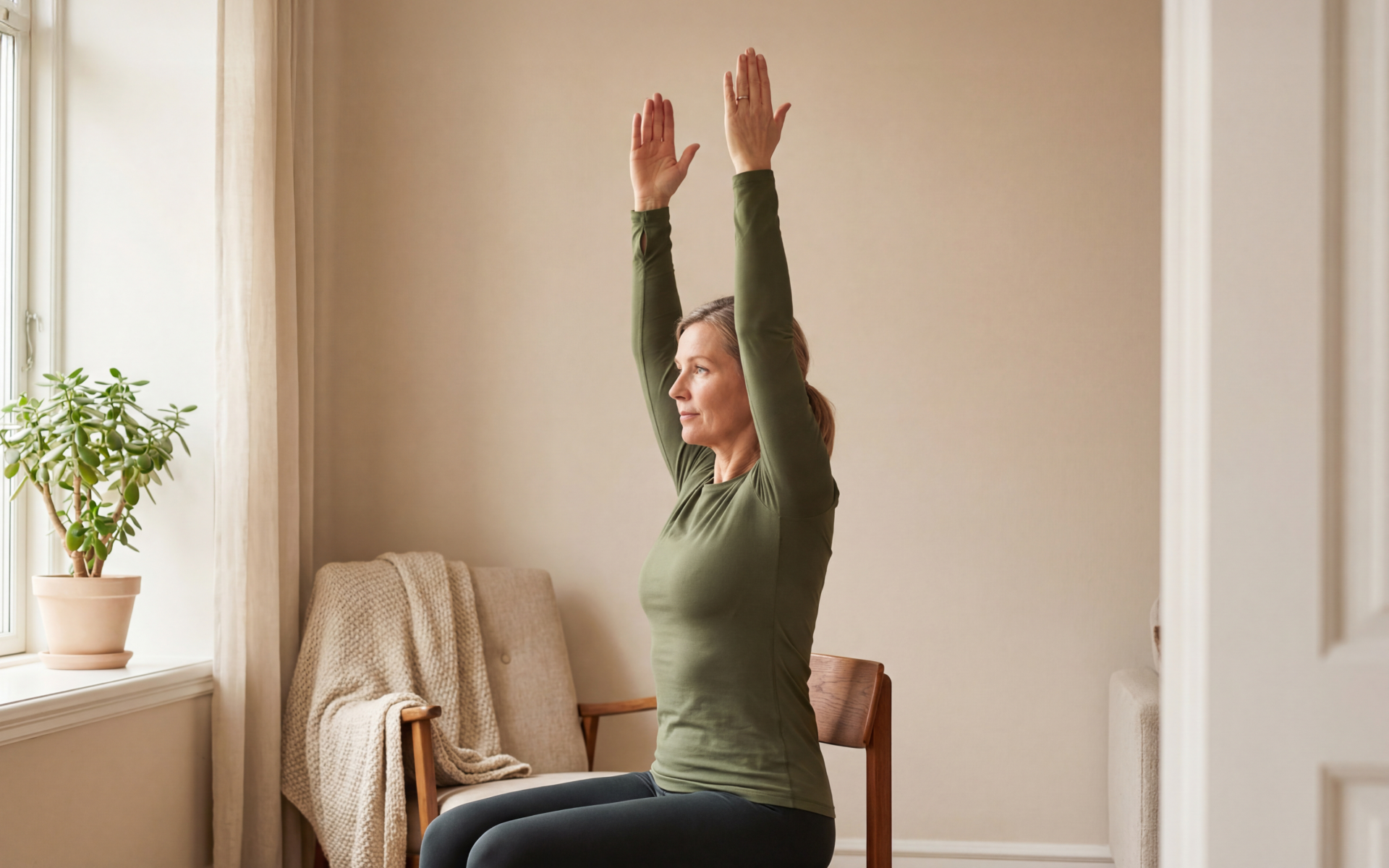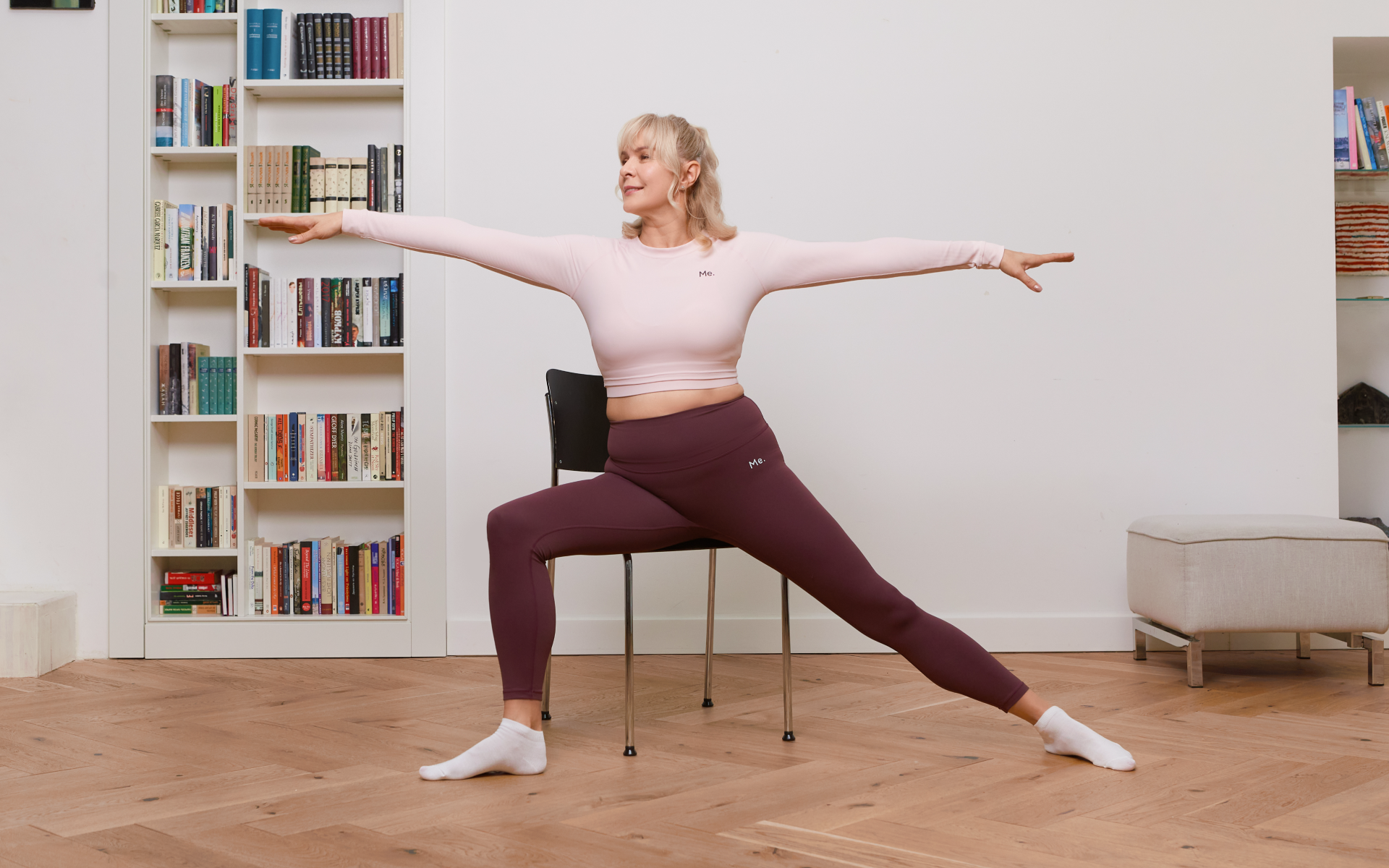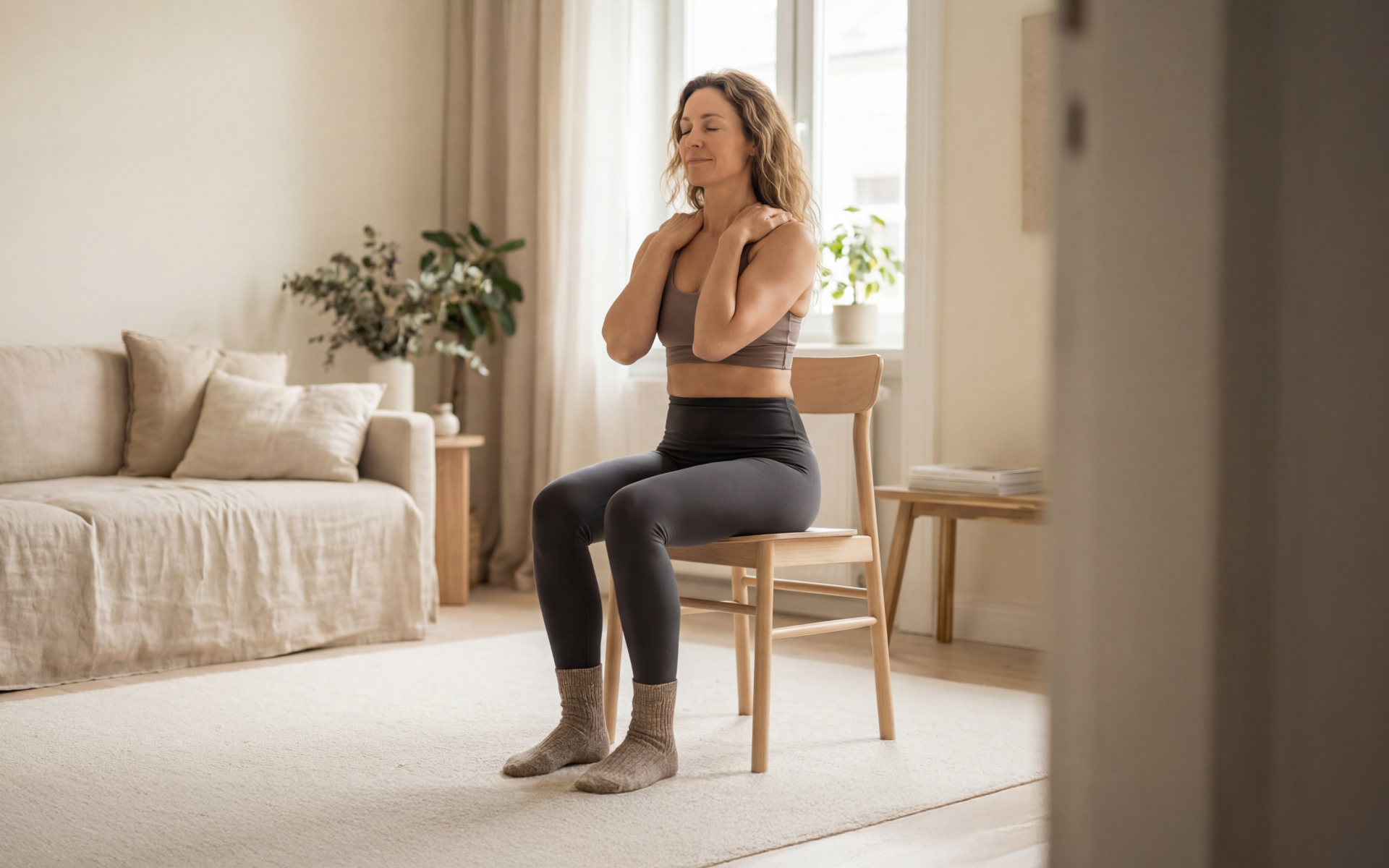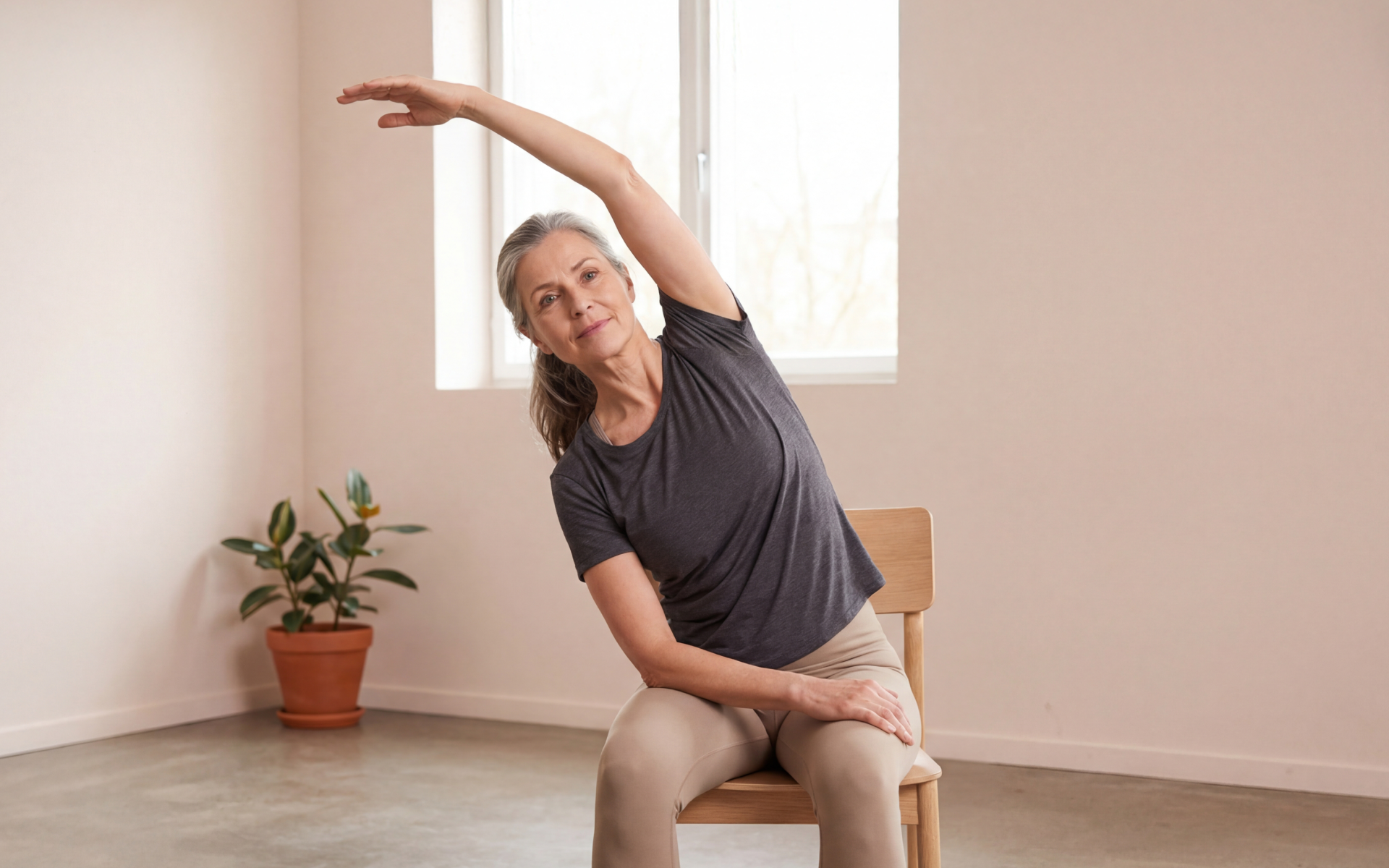Chair yoga opens up a world of gentle movement and flexibility for older adults who want to stay active without the demands of traditional floor-based practices.
This accessible form of exercise provides all the benefits of yoga (improved flexibility, better balance, and reduced stress) while offering the stability and support that many seniors need.
Regular physical activity can help seniors maintain independence, prevent falls, and improve overall quality of life. Chair yoga aligns perfectly with this framework by making movement accessible to individuals with varying mobility levels and physical limitations.
Here’s everything you need to know about chair yoga for seniors, including 6 specific exercises you can incorporate into your daily routine.
Is Chair Yoga Easy Enough For Senior Beginners?
Yes, it is. Chair yoga was specifically designed to make yoga accessible to individuals who may struggle with traditional mat-based poses. For seniors, this translates to a practice that recognizes the body’s current capabilities while still providing meaningful physical and mental benefits.
As we age, our bodies naturally experience changes in flexibility, balance, and muscle strength (1).
To mitigate this decrease in fitness, the Centers for Disease Control and Prevention (CDC) recommends that adults aged 65 and older engage in:
- At least 150 minutes of moderate-intensity aerobic activity weekly, plus
- Muscle-strengthening activities on 2+ days per week (2).
However, many seniors face barriers to traditional exercise, including joint stiffness, balance concerns, or mobility limitations.
Chair yoga addresses these challenges by providing external support through the chair while still encouraging movement and stretching (3).
The seated position eliminates the fear of falling that might prevent some seniors from trying other forms of exercise (4). Additionally, you or the trainer can modify most chair yoga movements further based on individual needs and limitations.
The gentle nature of chair yoga makes it particularly suitable for seniors who are new to exercise or returning to movement after a period of inactivity. Unlike high-impact activities that might stress joints or require significant cardiovascular fitness, chair yoga allows participants to work within their comfort zone while gradually building strength and flexibility.
Most importantly, chair yoga doesn’t require any previous yoga experience.
The movements are intuitive and based on natural body mechanics, making them easy to learn and remember. This accessibility factor is crucial for seniors who might feel intimidated by traditional fitness classes or complex exercise routines.
Read more: Chair Yoga for Seniors Benefits: Little-Known Advantages of This Modified Exercise
Can You Lose Weight With Chair Yoga For Seniors?
Numerous chair workout benefits can improve your life and health. The one that many are interested in is weight loss; can chair yoga help with fat loss?
Weight management becomes increasingly complex as we age, with several factors playing a role, such as (5, 6):
- Slower metabolism
- Hormonal
- Reduced muscle mass
While chair yoga alone may not lead to dramatic weight loss, it can be a valuable component of a comprehensive approach to healthy weight management for seniors.
Weight loss requires creating a caloric deficit, burning more calories than you consume (7). Being a gentle form of exercise, a 30-minute chair yoga session typically burns between 50 and 100 calories. This calorie burn will depend on the intensity and the individual’s body weight.
Reasons why BetterMe is a safe bet: a wide range of calorie-blasting workouts, finger-licking recipes, 24/7 support, challenges that’ll keep you on your best game, and that just scratches the surface! Start using our app and watch the magic happen.
However, chair yoga contributes to weight management in several indirect but vital ways.
- Regular practice can help improve posture, which creates the appearance of a leaner silhouette and can boost confidence.
- The stress-reduction benefits of yoga may help regulate cortisol levels (8), which can influence weight distribution, particularly around the midsection (9).
- Chair yoga improves overall functional fitness and muscle strength (10).
- Chair yoga also serves as a safe and excellent starting point for seniors who want to become more active (11).
- Many chair yoga beginners find that the gentle chair exercises help build confidence and physical capability. This self-assurance eventually leads them to incorporate additional forms of movement into their routine. Ultimately, this can create a more significant caloric expenditure over time.
The mindfulness component of chair yoga plays a significant role in weight management. Regular yoga practice can help seniors develop better awareness of hunger and fullness cues, potentially leading to more mindful eating habits (12).
This awareness is particularly valuable for seniors who might eat out of boredom or stress rather than actual hunger.
For seniors interested in incorporating chair yoga into a weight management strategy, consistency is crucial. Daily practice of yoga contributes to overall health improvements that may include modest weight loss over time (13). The effect is more profound when combined with attention to nutrition and other forms of movement.
If weight loss is a primary goal, consider exploring chair workout for weight loss routines that incorporate more vigorous movements while still maintaining the seated position for safety and accessibility.
How To Do Easy Chair Yoga For Seniors Beginners
Starting a chair yoga practice requires minimal equipment, but thoughtful preparation is essential to ensure safety and effectiveness.
The foundation of successful chair yoga lies in proper setup and understanding basic principles before moving into specific exercises.
- Choosing The Right Chair
Select a sturdy chair with a straight back and no wheels.
The chair should allow your feet to rest flat on the floor with your knees at approximately a 90-degree angle. It shouldn’t have armrests, as these can get in the way of certain poses.
Kitchen or dining room chairs often work well, while office chairs with wheels can be unstable, and practitioners should avoid using them.
Position your stable chair on a non-slip surface, and you should have enough space around you to extend your arms comfortably in all directions. If you’re practicing on a slippery floor, consider placing a yoga mat or towel under the chair legs for added stability.
- Establishing Proper Posture
Begin each session by establishing a good seated posture.
- Sit toward the front half of the chair seat, allowing your back to maintain its natural curve without relying on the chair back for support.
- Your feet should be flat on the floor, hip-width apart. Keep your shoulders relaxed and away from your ears, with your head balanced over your spine.
This neutral spine position serves as your home base throughout the practice and helps prevent strain or discomfort.
- Breathing Foundation
Chair yoga combines coordinated breathing with movement, enhancing relaxation and helping you move more mindfully. Therefore, before beginning any movements, spend a few minutes focusing on your breath.
Practice taking slow, deep breaths through your nose, allowing your ribcage to expand on the inhale and gently contract on the exhale. This breathing pattern should feel natural and never forced.
The breath serves as your guide throughout the practice. If you find yourself holding your breath during a movement, it’s a sign to slow down or reduce the intensity.
- Movement Principles
Chair yoga movements should always feel comfortable and controlled. Never push into pain or force your body into positions that feel unstable. The goal is gentle mobility and stress relief, not aggressive stretching or strengthening.
Start each movement slowly and pay attention to how your body responds. You can always increase the range of motion gradually as your flexibility improves, but beginning conservatively helps prevent injury and builds confidence.
Remember that chair yoga is adaptable. If a particular movement doesn’t feel right for your body, modify it or skip it entirely. Your practice should feel nurturing and supportive, not challenging or uncomfortable.
For those ready to expand their practice beyond these basics, a full chair workout for seniors can provide additional variety and challenge while maintaining the safety and accessibility of the seated position.
What Is An Easy Chair Yoga For Seniors To Do Everyday?
Many wonder, “What is the easiest chair yoga for seniors?”
The following 6 exercises form one of the easiest and complete daily chair yoga routines that address the most common areas of stiffness and tension experienced by seniors.
Each exercise targets specific muscle groups and joints, promoting better posture and improved circulation.
Perform these exercises within 15-20 minutes, resting for at least 1 minute between each pose. You may repeat the entire routine twice, with a 3-minute break in between the sets.
Seated Mountain Pose With Shoulder Rolls
This foundational pose helps establish proper posture while releasing tension in the shoulders and upper back, areas where many seniors hold stress and stiffness.
The combination of postural awareness and shoulder mobility makes this exercise ideal for beginning each practice session.
Shoulder rolls work by gently mobilizing the shoulder joint through its full range of motion, helping to counteract the forward-rounded posture that often develops from daily activities like reading, computer work, or household tasks.
Steps to perform:
- Sit tall in your chair with feet flat on the floor, hip-width apart
- Place your hands gently on your thighs and take 3 deep breaths.
- Slowly roll your shoulders up toward your ears, back, and down in a smooth circular motion.
- Repeat 5 times in one direction, then reverse for 5 repetitions.
- Return to neutral and notice the sensation in your shoulders and upper back.
Seated Spinal Twist
Spinal mobility tends to decrease with age, particularly rotational movement. This gentle twist helps maintain the spine’s natural ability to rotate while providing a massage-like effect for the internal organs and promoting better digestion.
The seated position provides stability for this movement, allowing you to focus on the spinal rotation without worrying about balance. The twist also helps counteract the effects of spending long periods in one position.
Steps to perform:
- Sit up straight with both feet flat on the floor
- Place your right hand on the outside of your left thigh.
- Place your left hand on the back of your chair or on the chair seat beside you.
- On an exhale, gently rotate your torso to the left, starting from your lower ribs.
- Hold for 3-5 breaths, then slowly return to center.
- Repeat on the opposite side.
BetterMe: Health Coaching app helps you achieve your body goals with ease and efficiency by helping to choose proper meal plans and effective workouts. Start using our app and you will see good results in a short time.
Seated Cat-Cow Stretch
This movement addresses the entire length of the spine, promoting flexibility and mobility from the neck to the lower back. The cat-cow motion helps counteract stiffness from prolonged sitting and can provide relief for minor back discomfort.
The spinal flexion and extension involved in this exercise help maintain the spine’s natural curves and promote circulation to the spinal discs. This movement is particularly beneficial for seniors who spend significant time in seated positions.
Steps to perform:
- Sit toward the front of your chair with your hands resting on your knees
- On an inhale, arch your back gently, lifting your chest and looking slightly upward (cow pose)
- On an exhale, round your spine, dropping your chin toward your chest and gently contracting your abdominals (cat pose)
- Move slowly between these 2 positions, coordinating with your breath.
- Repeat 5-8 times, focusing on moving one vertebra at a time.
Seated Forward Fold
This gentle forward fold provides a mild stretch for the entire back body, including the spine, hamstrings, and calves. The movement promotes flexibility while offering a calming, introspective quality that can help reduce stress and anxiety.
The seated version makes this classic yoga pose accessible to seniors who might not be able to perform a standing forward fold safely. The chair provides support and security while still allowing for a meaningful stretch.
Steps to perform:
- Start in an upright seated position with feet flat on the floor
- Take a deep breath and lengthen your spine.
- On an exhale, slowly hinge forward from your hips, keeping your back straight.
- Let your arms hang naturally, or rest your forearms on your thighs.
- Hold for 5-8 breaths, then slowly roll up to seated, one vertebra at a time.
Seated Side Stretch
Side body flexibility often gets neglected in daily movement, leading to stiffness in the muscles between the ribs and along the sides of the torso. This stretch helps maintain lateral spinal flexibility while opening the rib cage for better breathing.
The lateral stretch also provides a gentle opening for the often-tight muscles around the waist and lower ribs. This movement can be particularly beneficial for seniors who experience stiffness from sleeping in one position or from repetitive daily activities.
Steps to perform:
- Sit tall with both feet flat on the floor
- Raise your right arm overhead, keeping your left hand on your thigh for support.
- On an exhale, gently lean to your left, creating a gentle curve along your right side
- Breathe deeply and feel the stretch along your right ribs and waist.
- Hold for 5 breaths, then slowly return to the center and repeat on the other side.
Ankle Circles and Calf Raises
Lower leg circulation can become sluggish with age, particularly for seniors who spend long periods seated. This combination movement promotes blood flow while maintaining ankle mobility and strengthening the calf muscles.
Ankle mobility is crucial for maintaining walking stability and preventing falls.
The circular motion helps maintain a range of motion in all directions, while calf raises provide gentle strengthening for the muscles that support balance and walking.
Steps to perform:
- Sit comfortably with both feet flat on the floor
- Lift your right foot slightly off the ground and slowly circle your ankle 5 times in each direction.
- Place your right foot down and repeat with your left ankle.
- With both feet flat, slowly raise onto your toes, lifting your heels as high as comfortable.
- Lower slowly and repeat 8-10 times.
- Finish by flexing both feet, pulling your toes toward your shins.
These exercises work synergistically to address the most common areas of stiffness and mobility concerns for seniors. For additional variety and challenge, consider exploring more comprehensive Chair Workout Benefits that can complement your daily routine.
Read more: Chair Yoga Goddess Squat (Utkata Konasana): A Comprehensive Guide
How Often Should I Do Chair Exercises For Seniors?
The frequency of chair yoga practice should align with current physical activity guidelines while considering individual capabilities and goals (14).
For chair yoga specifically, daily practice is not only safe but encouraged.
The gentle nature of these exercises makes them suitable for everyday use, and consistency is key to reaping the most significant benefits for flexibility, posture, and stress management.
A realistic approach might involve practicing the 6-exercise routine outlined above daily, which takes approximately 10-15 minutes to complete.
This routine provides a foundation of daily movement while leaving room for additional activities throughout the week.
In addition to daily chair yoga, seniors should incorporate other types of physical activity as tolerated.
This additional activity might include:
- Balance exercises 2-3 times per week to help prevent falls and improve stability.
Many chair yoga movements naturally challenge balance in a safe way (15).
- Muscle-strengthening activities at least 2 days per week that work all major muscle groups (16). Chair yoga offers gentle strengthening, but seniors may benefit from incorporating additional resistance exercises.
- Flexibility and mobility work, which chair yoga addresses comprehensively.
The daily practice of gentle stretching helps maintain range of motion and can reduce stiffness (15).
On days when energy is lower or physical limitations are more pronounced, the practice can be shortened or modified. On days when you feel stronger, you can extend your routine or hold movements for longer periods.
Listen to your body and adjust accordingly.
If you experience any pain or unusual discomfort, reduce the intensity or consult with a healthcare provider. The goal is consistent, sustainable movement that enhances quality of life rather than creating additional stress or physical strain.
Several physiological changes contribute to increased abdominal size in women as they age. Hormonal shifts, particularly the decrease in estrogen during menopause, tend to redistribute fat storage from the hips and thighs to the abdominal area (17). Additionally, muscle mass naturally decreases with age, which can slow metabolism and make it easier to gain weight (5). Decreased physical activity due to frailty can also contribute to the development of a larger midsection (18). While chair yoga alone won’t eliminate these changes, regular practice can help improve posture and core engagement, creating a more toned appearance. Flattening the stomach at 70 requires a combination of approaches focused on realistic goals and sustainable methods. Regular core-strengthening exercises, such as modified exercises in a chair, help improve muscle tone and posture (19). Attention to nutrition, particularly reducing refined carbohydrates and processed foods, can help reduce bloating and inflammation (20). Staying hydrated and incorporating fiber-rich foods supports healthy digestion (21, 22). Most importantly, improving posture through exercises like those found in chair yoga can create the appearance of a flatter stomach while providing genuine health benefits. Consistency in movement and realistic expectations are key to success. Walking is generally considered the single most beneficial exercise for seniors due to its accessibility, low-impact nature, and comprehensive health benefits. Walking improves cardiovascular health, maintains bone density, supports mental health, and can be adapted to fit any fitness level (23). However, for seniors with mobility limitations or balance concerns, chair-based exercises become equally important. The “best” exercise is ultimately the one that a senior can perform safely and consistently. Chair yoga provides an excellent alternative or complement to walking, offering many similar benefits in a supported, seated position. Walking and chair exercises serve different purposes and complement each other rather than competing. Walking provides excellent cardiovascular benefits, weight-bearing exercise for bone health, and functional movement patterns used in daily life (24). Chair exercises excel at targeting specific muscle groups, improving flexibility, and providing a safe option for people with balance or mobility concerns (25). For optimal health, seniors benefit from incorporating both types of movement when possible. Chair exercises serve as a foundation for building strength and confidence, which eventually supports more walking. Conversely, walking can enhance the cardiovascular benefits that complement chair-based flexibility and strength work.Frequently Asked Questions
Why do women’s stomachs get bigger with age?
How can a 70-year-old woman flatten her stomach?
What is the number one exercise seniors should do?
Is walking better than chair exercise?
The Bottom Line
Chair yoga represents more than just a gentle exercise option; it’s a gateway to maintaining independence, reducing stiffness, and supporting overall well-being as you age. The 6 exercises outlined in this guide provide a comprehensive daily routine that addresses the most common physical challenges seniors face, from spinal stiffness to reduced circulation.
The beauty of this practice lies in its sustainability and adaptability.
Unlike exercise programs that require specific equipment, weather conditions, or complex scheduling, chair yoga can become as routine as your morning coffee or evening news. This consistency is what transforms simple movements into meaningful improvements in flexibility, posture, and quality of life.
Remember that every senior’s physical capabilities and limitations are unique to them.
These exercises provide a starting point that can be modified, expanded, or adapted based on your individual needs and progress, such as moving on to optional easy chair yoga for seniors with weights. The goal is not perfection but relatively consistent, gentle movement that honors your body’s current capabilities while encouraging gradual improvement.
DISCLAIMER:
This article is intended for general informational purposes only and does not serve to address individual circumstances. It is not a substitute for professional advice or help and should not be relied on for making any kind of decision-making. Any action taken as a direct or indirect result of the information in this article is entirely at your own risk and is your sole responsibility.
BetterMe, its content staff, and its medical advisors accept no responsibility for inaccuracies, errors, misstatements, inconsistencies, or omissions and specifically disclaim any liability, loss or risk, personal, professional or otherwise, which may be incurred as a consequence, directly or indirectly, of the use and/or application of any content.
You should always seek the advice of your physician or other qualified health provider with any questions you may have regarding a medical condition or your specific situation. Never disregard professional medical advice or delay seeking it because of BetterMe content. If you suspect or think you may have a medical emergency, call your doctor.
SOURCES:
- Movement and Aging (2023. intechopen.com)
- What Counts as Physical Activity for Older Adults (2023, cdc.gov)
- How to Do Chair Yoga (2024, webmd.com)
- Safety and feasibility of modified chair-yoga on functional outcome among elderly at risk for falls (2012, pmc.ncbi.nlm.nih.gov)
- Metabolic changes in aging humans: current evidence and therapeutic strategies (2022, pmc.ncbi.nlm.nih.gov)
- Hormonal and Metabolic Changes of Aging and the Influence of Lifestyle Modifications (2021, pmc.ncbi.nlm.nih.gov)
- “Calories in, calories out” and macronutrient intake: the hope, hype, and science of calories (2017, journals.physiology.org)
- Reducing Stress with Yoga: A Systematic Review Based on Multimodal Biosignals (2024, pmc.ncbi.nlm.nih.gov)
- Stress and Obesity (2019, annualreviews.org)
- Effectiveness of Chair Yoga for Improving the Functional Fitness and Well-being of Female Community-Dwelling Older Adults With Low Physical Activities (2019, journals.lww.com)
- The Effectiveness of Chair Yoga in Older Adults: A Literature Review (2023, researchgate.net)
- Development and Validation of the Mindful Eating Questionnaire (2009, pmc.ncbi.nlm.nih.gov)
- The impact of yoga on aging physiology: A review (2024, sciencedirect.com)
- Physical Activity Guidelines for Americans, 2nd edition (2018, odphp.health.gov)
- Exercise Prescription for Older Adults (journals.lww.com)
- Resistance Training for Older Adults: Position Statement From the National Strength and Conditioning Association (2019, journals.lww.com)
- Estrogen Deficiency and the Origin of Obesity during Menopause (2014, pmc.ncbi.nlm.nih.gov)
- Effect of Age and Weight on Physical Activity (2020, journals.sagepub.com)
- The Importance of Core Strength for Overall Fitness (2023, news-medical.net)
- Nutritional and lifestyle management of the aging journey: A narrative review (2023, frontiersin.org)
- Hydration Status in Older Adults: Current Knowledge and Future Challenges (2023, pmc.ncbi.nlm.nih.gov)
- Fibre4life: Investigating older adults dietary fibre preferences and the role of targeted educational materials on modulating future dietary fibre intake (2024, Sciencedirect.com)
- 12 Benefits of Walking (n.d., arthritis.org)
- The multifaceted benefits of walking for healthy aging: from Blue Zones to molecular mechanisms (2023, link.springer.com)
- The Effect of Chair-Based Exercise on Physical Function in Older Adults: A Systematic Review and Meta-Analysis (2021, pmc.ncbi.nlm.nih.gov)
